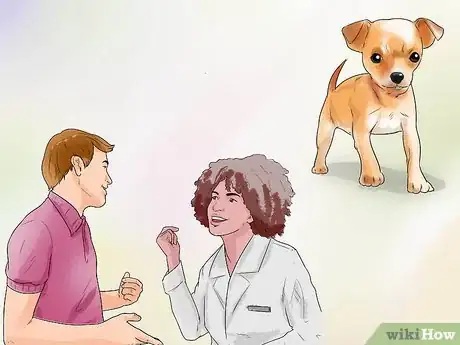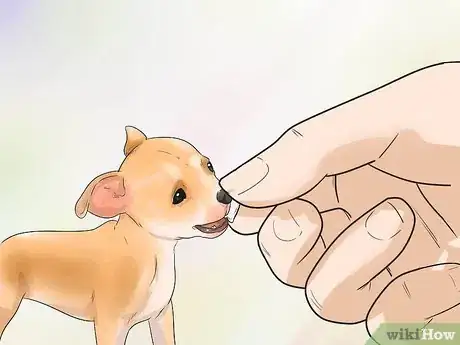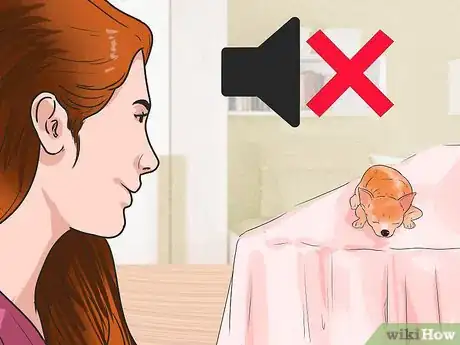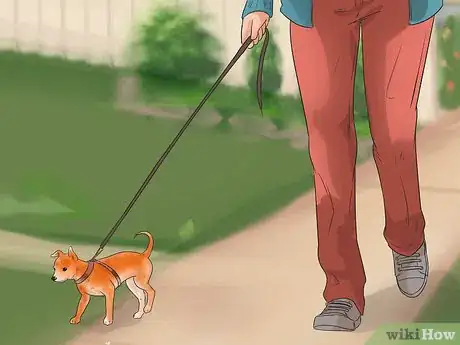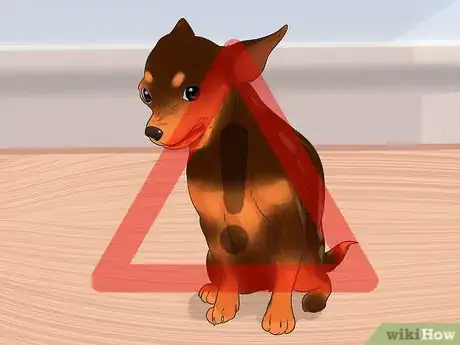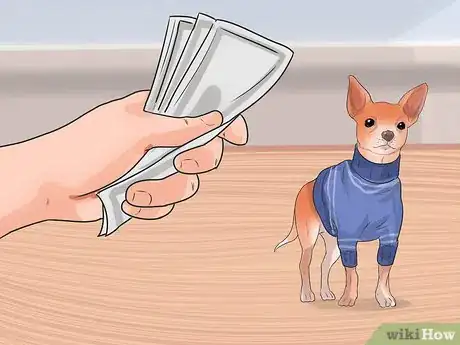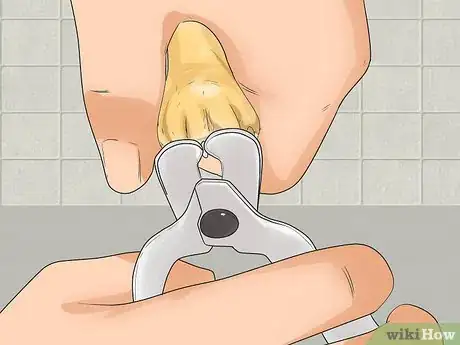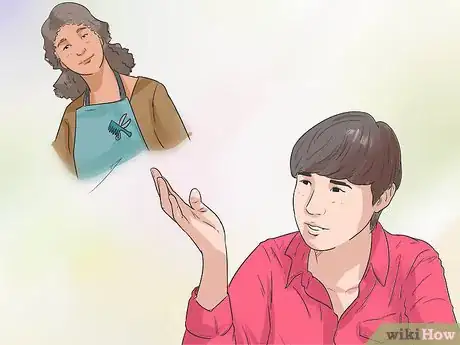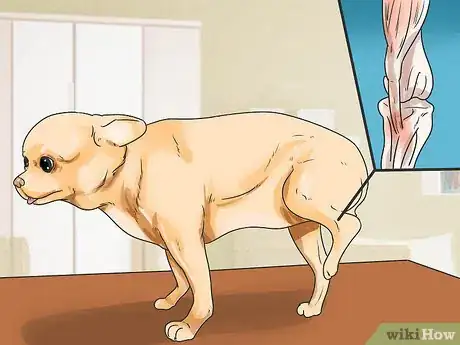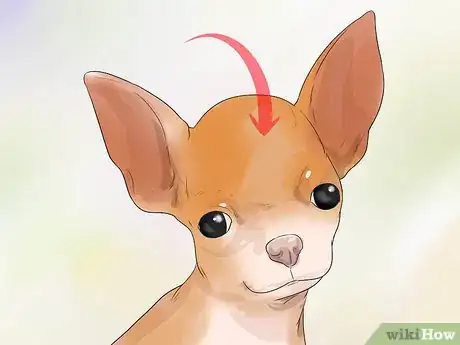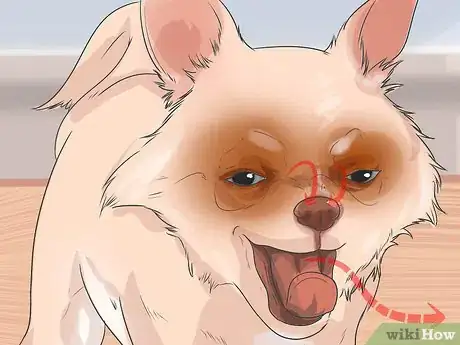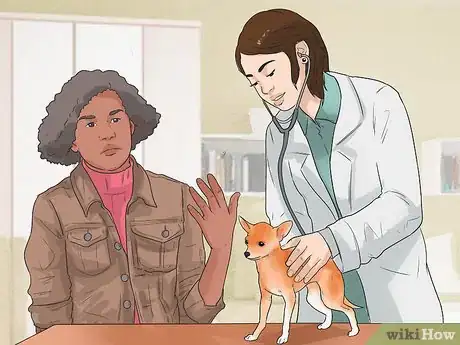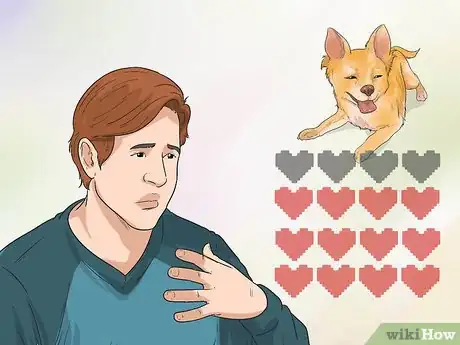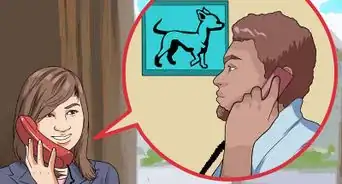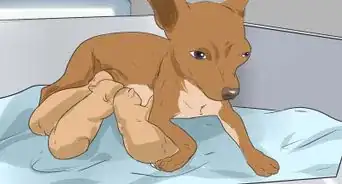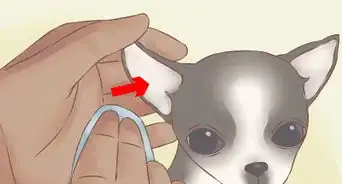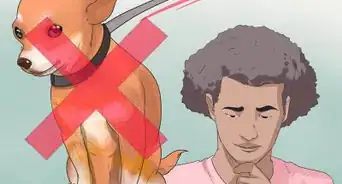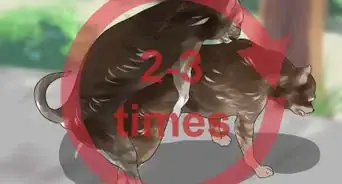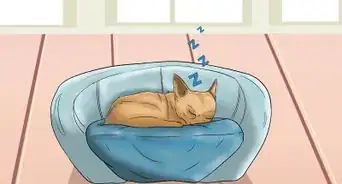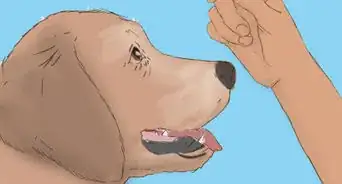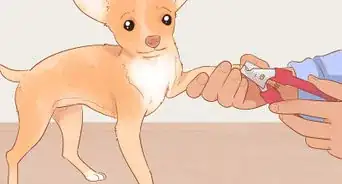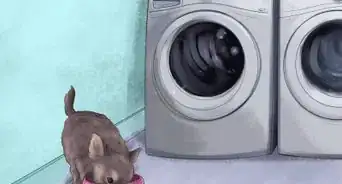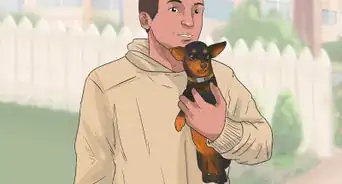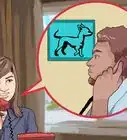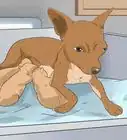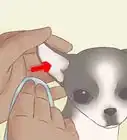This article was co-authored by Pippa Elliott, MRCVS. Dr. Elliott, BVMS, MRCVS is a veterinarian with over 30 years of experience in veterinary surgery and companion animal practice. She graduated from the University of Glasgow in 1987 with a degree in veterinary medicine and surgery. She has worked at the same animal clinic in her hometown for over 20 years.
There are 11 references cited in this article, which can be found at the bottom of the page.
This article has been viewed 60,493 times.
Teacup chihuahuas are not an official breed. Rather, they are just regular chihuahuas that are either the runt of the litter or specifically bred to be smaller.[1] Often, that leads to specific health problems that you need to be aware of when you have a toy breed. Also, you need to take special care with any smaller dogs.
Steps
Providing Daily Care for Your Chihuahua
-
1Consult your veterinarian for care recommendations. Whenever you get a new dog, it's always best to have it checked out by a veterinarian. In addition, your vet can provide you with guidance about how to best care for your new teacup chihuahua, particularly since there are health problems associated with this type of dog.
- In addition, your veterinarian can provide any vaccinations your dog may need.
-
2Feed your teacup chihuahua sparingly. It's easy to overfeed teacup chihuahuas because they are so small. Therefore, many chihuahuas are at risk for being overweight. Limit the amount of food you feed your chihuahua each day, including treats.
- Since most teacup chihuahuas are under 5 pounds, 1/2 a cup of dog food or less each day is enough.[2]
- If you notice your dog is gaining weight, try reducing it's food intake.
Advertisement -
3Reduce stress. Small dogs like teacup chihuahuas are more prone to stress. Because they are so small, you may be want to carry them around with you, which can cause more stress. Learning ways to reduce your pet's stress is important for its health and well-being.[3]
- Give the dog a place to retreat to that is a low-stress environment, such as a room that is relatively quiet. You can also have a crate with bedding in it.
- Try not to make loud noises around your chihuahua.
- In addition, don't hand your chihuahua over to someone to hold if your dog doesn't already know the person. Being handed to an unknown person can stress the dog out.
-
4Be vigilant about bathroom breaks. Small dogs like chihuahuas mean small bladders. You need to let them go to the bathroom more often, or you'll end up with a puddle on the floor. One way to remind yourself is to set a timer at regular intervals during the day to remind yourself to let your dog out, once you figure out your dog's bathroom needs.[4]
-
5Make sure your chihuahua gets enough exercise. Adult chihuahuas should get about 30 minutes of exercise every day, usually in the form of a walk. Swimming is also good exercise, as long as you are supervising the chihuahua during the exercise.[5]
- On hot days, think about the heat of the pavement. If you wouldn't walk on it barefoot, your chihuahua shouldn't either. Also, try to go outside when it's cooler out on hot days.
- Use a harness instead of a collar, as it is less likely to cause injury and makes it more difficult for your chihuahua to slip out of it.
-
6Watch out for small dog syndrome. Small dogs, including teacup chihuahuas, have a reputation for being snappy and somewhat aggressive. However, this behavior isn't more innate to small dogs than it is to large dogs. Rather, it's just more tolerated in small dogs because it's seen as cute or less dangerous.[6]
- In other words, you need treat this behavior in your dog the same way you would in a large dog. If you saw a large dog growling and snapping at someone, would you let that behavior continue? No, you'd put a stop to it. You need to employ the same techniques with your small dog, even if it seems "cute" at the time.
-
7Think about a sweater. You may have noticed that your teacup chihuahua is often shivering. That's because they are so small that they are often cold. To help combat the coldness, consider buying a sweater for your chihuahua. It's best to start your dog on a sweater when it's young so it can get used to it.[7]
Grooming Your Chihuahua
-
1Brush your chihuahua regularly. Brush both short-haired and long-haired varieties at least once a week. You can use a soft bristle brush for both varieties, though you can also use a rubber grooming brush on short-haired chihuahuas. For tangles, use a tangle comb to gently pick them out.[8]
-
2Bathe your chihuahua as needed. You only really need to bathe your chihuahua when it gets dirty or starts to smell. If you'd like, you can wash it several times a week to keep your furniture cleaner and the shedding down.[9]
- While bathing your chihuahua, use a massaging motion, and speak gently to it to calm it down.
- Make sure to use a shampoo made for dogs. Look for one that says "gentle."
- Because chihuahuas are prone to being cold anyway, make sure you don't leave the dog damp.
-
3Trim your chihuahua's nails regularly. Most teacup chihuahuas do not get enough exercise to keep their nails worn down, so you need to trim them when you notice them getting long. It's important to start when your dog is young so it gets used to it over time.
- Pick trimmers meant for dogs, as they are quieter and more effective.
- Tuck your chihuahua under one arm and use one hand to hold one paw out at a time.
- Always look for the quick of the nail when getting ready to trim your dog's nails. The quick is the vein that runs through the nail. It should end about halfway to the tip. You don't want to cut the quick because it hurts the dog.
- The first few times try just cutting a couple of nails each time. Make sure to reward your dog afterward with petting and treats.
-
4Clean your dog's ears. Like most dogs, you should clean out your dog's ears as you notice them getting dirty. Your vet should have cleaning solutions available for your dog. Use cotton balls to wipe out your dog's ears, not going deeper than about 3/4 of an inch.[10]
-
5Consider a professional groomer. Grooming can be stressful for both you and pet. If you're having problems, your best option is to go to a professional groomer. If you are strapped for cash, try finding a grooming school in your area, which trains groomers. You'll still get professional service at a cheaper rate.
Recognizing Common Health Problems
-
1Treat your chihuahua with care. Small dogs are more susceptible to injury due to their size. In fact, teacup varieties of dogs often have brittle bones because of breeder techniques that stunt growth.[11] The teacup chihuahua is so small that accidentally dropping one can be fatal. In addition, because they are tiny, they are more difficult to see, and they are more likely to be stepped on or hit with a car. You have to take extra care to make sure your chihuahua isn't injured.[12]
- One thing that can help is to choose a brightly colored harness or collar for your dog so that the chihuahua stands out more.
- In addition, make sure to supervise your dog around heights, even couches.
- If you suspect your dog may have a broken bone, which you can recognize from swelling and pain in the area, take it to the vet.[13]
-
2Watch for low blood sugar. Due to their small size, teacup chihuahuas are more likely to get hypoglycemia. Splitting the dog's food throughout the day can help prevent hypoglycemia, since it gives your dog a steady flow of food to keep its blood sugar up. Try feeding it four times a day. In addition, it's important to watch for the signs of hypoglycemia in your dog.[14]
- Watch for extreme sleepiness, weakness, or dizziness. You may also notice seizures, restlessness, and increased hunger.[15]
- If you notice these symptoms, rub honey on the dog's gums, then go to a vet or veterinarian hospital.
- Some chihuahuas also develop the opposite problem and end up with high blood sugar, which is called diabetes. If your pup develops diabetes, speak to your vet about how to manage it.
-
3Check for signs of knee problems. Small dogs like chihuahuas can have trouble with the displacement of their kneecaps, called luxating patella. Watch for signs of this problem, which includes limping or hopping along when walking instead of walking normally. If you notice these symptoms, take your dog to the vet.[16]
-
4Look for water on the brain. Hydrocephalus, also called "water on the brain," often affects smaller chihuahuas. With this condition, fluid builds up in the brain, which can lead to complications like a different walking style, a larger brain, seizures, and blindness.[17]
- If you notice your dog is walking funny, that could be a sign of water on the brain. Seizures could include repeated movements or jerking. Your dog may also collapse, chomp its tongue, or foam at the mouth.[18]
- If you notice symptoms of this condition, talk to your vet. You may be able to manage some of the symptoms for your pet.
-
5Pay attention to signs of heart problems. Small dogs like teacup chihuahuas are more likely to develop heart issues than larger dogs. For instance, they are more prone to developing heart murmurs and more likely to have damaged heart valves. You need to watch for signs of heart disease in your chihuahua.[19]
- Signs of heart disease include listlessness, heavy breathing and panting, and coughing. You may also notice your dog stops eating or faints.
- If you notice these symptoms, take your dog to the vet.
-
6Take your dog to the veterinarian regularly. One way to stave off health problems is to make sure your dog sees the vet on a regular basis, as the vet will be better at spotting pre-warning signs of the diseases your dog is susceptible to than you are. Your dog should see a vet at least once a year.
-
7Be aware of the possibility of a shortened life. Teacup chihuahuas that are less than 3 pounds are more likely to have shortened lifespans. As noted, these dogs are susceptible to many health problems, which means they often live fewer years than larger chihuahuas.[20]
References
- ↑ http://www.petchidog.com/miniature-teacup-chihuahua
- ↑ http://www.petmd.com/blogs/nutritionnuggets/dr-coates/2015/july/are-you-feeding-your-dog-right-amount-32905#
- ↑ http://www.healthypawspetinsurance.com/blog/2015/08/18/teacup-dogs-health-issues/
- ↑ http://www.healthypawspetinsurance.com/blog/2015/08/18/teacup-dogs-health-issues/
- ↑ http://www.petchidog.com/chihuahua-exercise
- ↑ http://moderndogmagazine.com/articles/ask-expert-small-dog-syndrome/26546
- ↑ http://www.vetstreet.com/dogs/chihuahua#personality
- ↑ http://www.vetstreet.com/dogs/chihuahua#grooming
- ↑ http://www.vetstreet.com/dogs/chihuahua#grooming
- ↑ http://www.vetstreet.com/dogs/chihuahua#grooming
- ↑ http://www.healthypawspetinsurance.com/blog/2015/08/18/teacup-dogs-health-issues/
- ↑ http://www.petchidog.com/miniature-teacup-chihuahua
- ↑ http://www.healthypawspetinsurance.com/blog/2015/08/18/teacup-dogs-health-issues/
- ↑ http://www.petchidog.com/miniature-teacup-chihuahua
- ↑ http://www.healthypawspetinsurance.com/blog/2015/08/18/teacup-dogs-health-issues/
- ↑ http://www.vetstreet.com/dogs/chihuahua#health
- ↑ http://www.healthypawspetinsurance.com/blog/2015/08/18/teacup-dogs-health-issues/
- ↑ http://pets.webmd.com/dog-seizure-disorders
- ↑ http://www.healthypawspetinsurance.com/blog/2015/08/18/teacup-dogs-health-issues/
- ↑ http://www.vetstreet.com/dogs/chihuahua
About This Article
To take care of a teacup chihuahua, feed it no more than 1/2 cup of food each day to prevent obesity. Additionally, set up a crate or quiet room where it can relax, since toy breed dogs are prone to stress. You'll also need to take it out regularly for bathroom breaks, because of its small bladder. If you see your dog shivering, consider getting it a sweater since teacup chihuahuas have trouble producing body heat. For tips on how to spot medical problems with your teacup chihuahua, keep reading!
